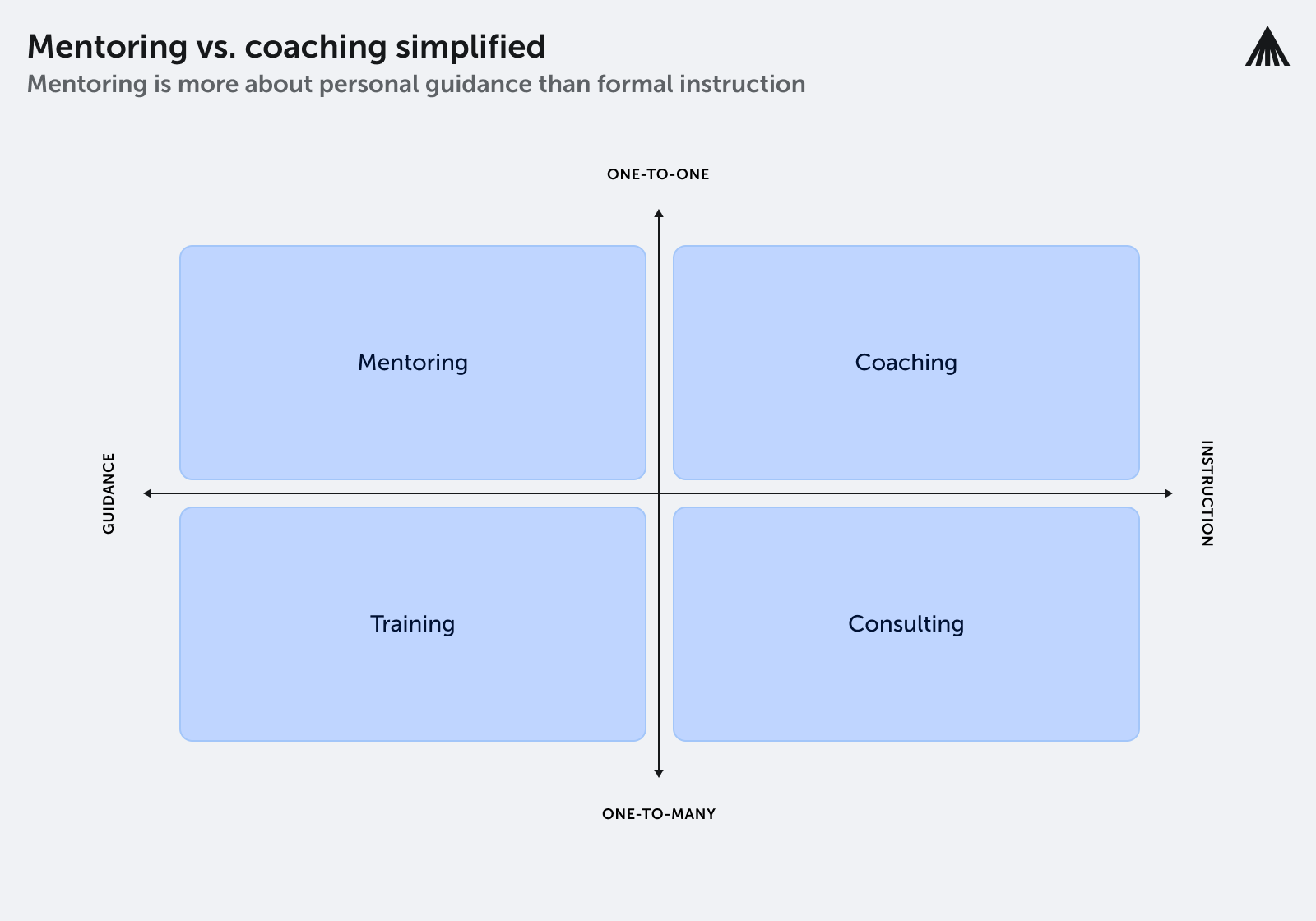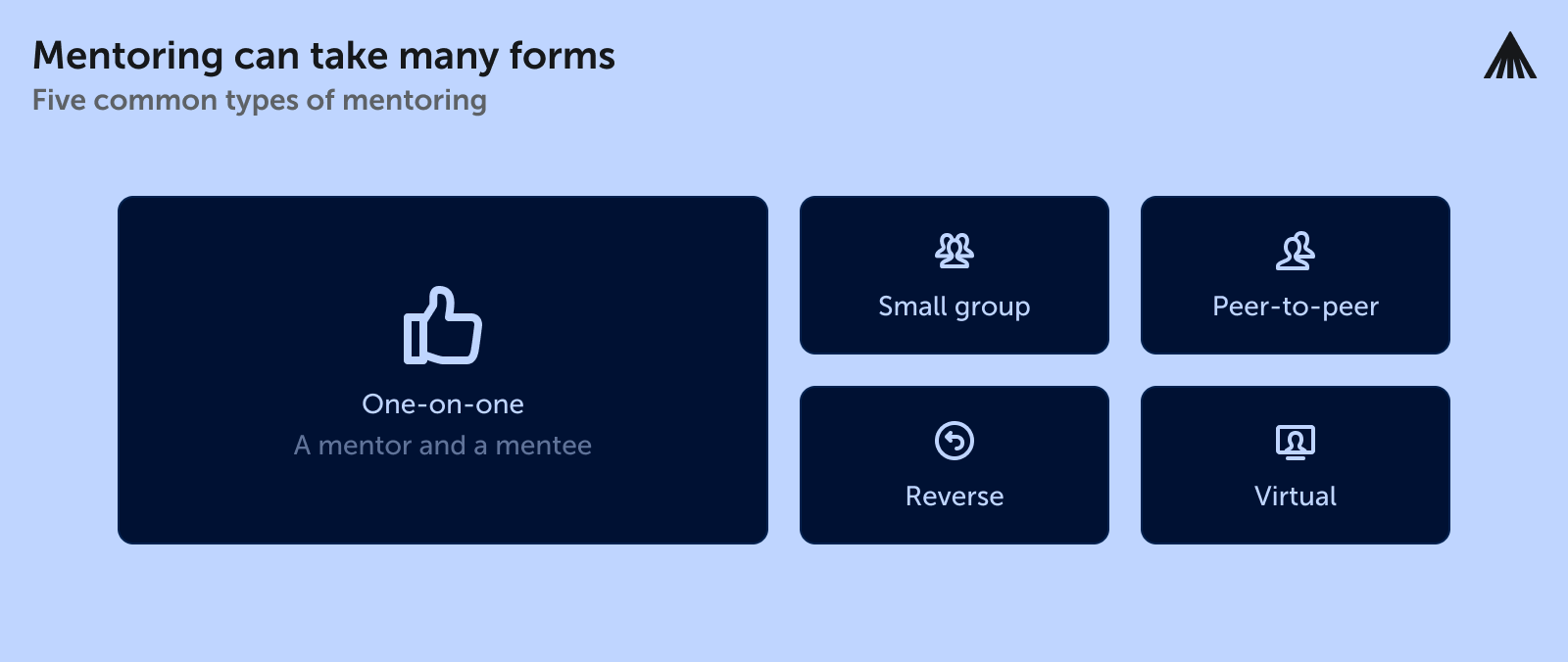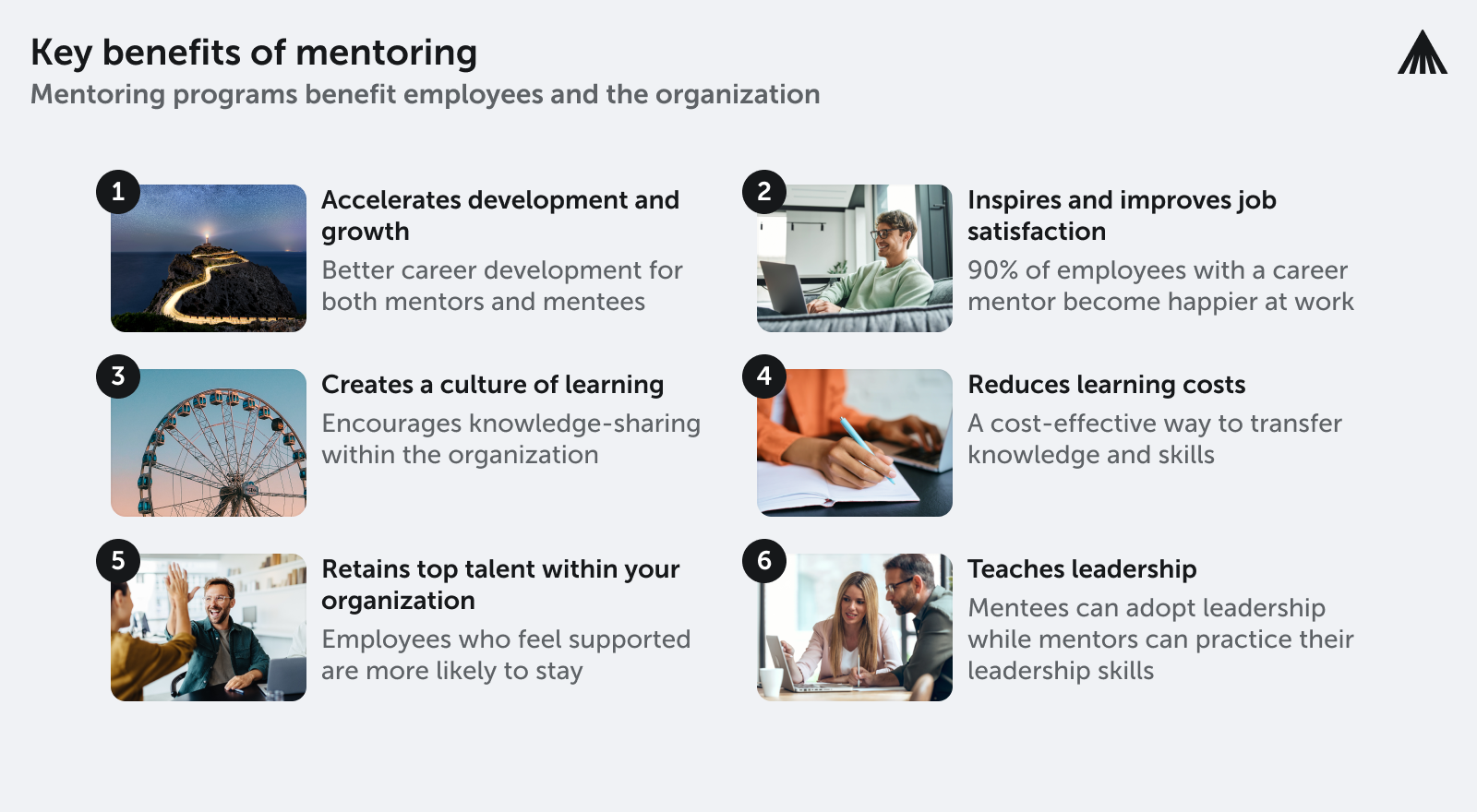Mentoring
Discover the essence of mentoring and how it differs from coaching. Explore the types of mentoring, its definition, and the numerous benefits it can bring to individuals and the workplace.

Learning from the experiences and wisdom of seasoned employees can help workers starting out in their careers grow and carve a path to success. Incorporating a mentoring program within your organization is a positive way to pass down expertise from senior employees and foster a culture of growth and progress.
“The only source of knowledge is experience.”
― Albert Einstein
In fact, 86% of CEOs surveyed in the August 2020 Vistage CEO Confidence Index survey reported that having a mentor played a significant part in their career journey. Many companies have recognized the benefits of mentoring for employee growth and have included it as part of employee development, with 90% of U.S. Fortune 250 companies reporting having mentoring programs.
In this article, you will learn:
- What is mentoring?
- What is a mentor?
- What is the difference between mentoring and coaching?
- Types of mentoring
- Benefits of a mentoring program for participants
- Mentoring program benefits for organizations
- Tips to develop a mentoring program
What is mentoring?
Mentoring is the practice of partnering junior staff members (mentees) with senior or experienced employees (mentors) for the purpose of advising, guiding, training, and developing the mentee’s skills and professional knowledge to help them grow in their careers. It requires a collaborative relationship that will enhance the mentee’s professional and personal growth and, at the same time, expand the mentor’s impact within the company.
Mentoring is a valuable development strategy to implement in your organization. From the organization’s perspective, a mentoring program’s goal is to strengthen employees’ focus skills and enhance professional development. By focusing on employees’ professional growth, organizations can deliver more value to their business and achieve their goals faster.
What is a mentor?
A mentor is an experienced and knowledgeable individual who offers guidance, support, and valuable insights to someone less experienced, typically referred to as a mentee.
Mentors play a crucial role in various aspects of life, such as professional development, personal growth, and skill enhancement. They share their expertise, provide advice, and serve as a source of inspiration and motivation, helping their mentees navigate challenges, make informed decisions, and reach their full potential.
Mentoring relationships can take various forms, including formal arrangements within organizations or informal connections formed through mutual interests, and they often contribute significantly to the mentee’s personal and professional development.
Ultimately, a mentor serves as a trusted advisor and role model, offering valuable guidance to help individuals achieve their goals and excel in their endeavors.
Purpose of mentoring
The purpose of mentoring is to facilitate personal and professional growth and development in individuals by leveraging the knowledge, experience, and guidance of a more experienced and knowledgeable individual, known as the mentor.
Mentoring serves several important purposes:
1. Skill and knowledge transfer
Mentoring allows for transferring knowledge, skills, and expertise from the mentor to the mentee. This can include industry-specific knowledge, best practices, problem-solving techniques, and more.
Mentors can help boost a mentee’s self-confidence by encouraging and acknowledging strengths and achievements.
2. Career development
Mentoring can help mentees navigate their career paths more effectively.
Mentors can advise on career choices, help set and achieve career goals, and offer insights into advancing within a particular profession or organization.

Career development plan template
This template helps employees and leaders plan together for career growth: set goals, assess skills, and make a plan.
Download now3. Role modeling
Mentors serve as role models, demonstrating professionalism, ethics, and values in action.
They can inspire and motivate mentees by setting an example of what success looks like.
4. Succession planning
In organizations, mentoring can be a part of succession planning, ensuring that the knowledge and skills of experienced employees are passed down to newer employees, thus ensuring continuity and stability.
Check out our Succession Planning Template.
5. Diversity and inclusion
Mentoring can play a crucial role in promoting diversity and inclusion by providing support and guidance to individuals from underrepresented groups in various fields.
What is the difference between mentoring vs. coaching?
Both mentoring and coaching can be used in a professional setting for the purpose of career development and require similar skills, but it is important to understand the difference between the two before creating your own mentoring program.

1. Required skills:
Mentoring – Mentors do not typically need to be trained in specific skills when beginning a mentoring program because they are more focused on passing down knowledge they already possess.
Coaching – Coaches usually receive formal training in a specific area of expertise before beginning a coaching program in order to teach and train their proteges.
2. Formality of relationships:
Mentoring – Mentoring typically takes a more informal approach, where development is achieved through relaxed conversations between mentors and mentees.
Coaching – Coaching typically has a more formal approach since coaches receive formal training before meeting with learners and coaching sessions are more rigid as they follow a structured training program.
3. Short vs. long-term programs:
Mentoring – Mentoring is typically seen as a more long-term process and can extend for a period of time if mentees wish to continue seeking advice and guidance from their mentors.
Coaching – Coaching is usually a short-term solution when a coach is brought in to teach a specific skill or help the learner reach a specific goal, and once that goal is met, the relationship is terminated.
4. Performance vs. development:
Mentoring – Mentoring focuses on the general development of an individual over a more extended period of time.
Coaching – Coaching is hyper-focused on reaching a specific goal and measuring the process through performance metrics in order to refine skills needed to reach the set goal.
5. Meeting structures:
Mentoring – Mentoring meeting structures are more informal conversations, and the mentee sets the meeting topics and focus areas in advance.
Coaching – Coaching sessions typically follow a rigorous structure set in advance by the coaches to meet the learner’s specific needs.
Types of mentoring
There are many different types of mentoring, and it is essential first to figure out which type of mentorship will work best for your organization and for the participants.

1. One-on-one mentoring
One-on-one mentoring is the most traditional type of mentorship and typically consists of a senior, experienced person (mentor) and a less experienced one (mentee).
The benefit of this type is in relationship approach and connection. A mentor and mentee can focus on the exact development needs of the mentee and, as a result, speed up the entire process.
One-on-one mentoring is suitable for succession planning.
2. Group mentoring
Group mentoring involves a single, qualified mentor working with a small group of mentees. This type of mentorship is primarily used in schools or youth programs, where there are higher numbers of mentee participants.
The main benefit of this type is that it can be used in organizations to develop a group of employees at once by one mentor.
3. Peer mentoring
In a peer mentoring program, the mentor and mentee have the same roles and departments or have shared or similar experiences. And most likely, they change their roles from time to time because they can learn from each other.
This type of mentorship focuses on experience exchange, adoption of the best practices, or creating a supportive relationship between the two participants.
5. Reverse mentoring
Reverse mentoring happens when the mentor-mentee relationship flips with the junior employee in the mentor role and the senior employee in the mentee role.
This situation is helpful when the junior employee uses their fresh perspective to teach new skills or provide technical instruction to the senior employee.
5. Virtual mentoring
Virtual mentoring is more common in today’s remote work culture. The advancement of technology and the flexibility to meet with people virtually worldwide allows people to have more opportunities when choosing a mentor.
Benefits of a mentoring program for participants
A mentoring program offers substantial benefits to both mentors and mentees, as research points to 84% of reporting participants believing the relationship is a two-way source of inspiration.
For mentors, it provides an opportunity to share their expertise and experience, fostering a sense of fulfillment and accomplishment, while mentees gain invaluable guidance, insights, and support, accelerating their professional and personal growth.
Ultimately, both participants benefit from a mutual knowledge exchange and a rewarding partnership that drives success.

1. Accelerates development and growth
Mentorship programs can support career development for both participants. Both mentors and mentees are 20% more likely to get a raise than individuals who do not participate in these programs.
Participants are also more likely to experience professional promotions than non-program participants, with mentees five times more likely to get promoted and mentors six times more likely.
Discover our Career Development Plan Template that helps both employees and their supervisors to work together to achieve career growth and development.
2. Inspires and improves job satisfaction
A mentorship can inspire or challenge participants to get outside their comfort zone and learn something new.
Being in a mentor/mentee relationship can also improve job satisfaction, as 90% of employees with a career mentor reported being happier at work.
3. Grows personal networks & connections
Mentoring can expand a mentee’s professional network as mentors often introduce mentees to other professionals to facilitate opportunities for organizational collaboration, job referrals, and career advancement.
Research shows 82% of mentor participants believe that mentoring relationships help foster meaningful connections between mentors and mentees as well as across departments of their organization.
4. Exposure to new and different perspectives
A mentorship can provide fresh insights into a situation, process, or business from a different angle. Mentees can learn how to do something for the first time, gain a better understanding of the business, launch new projects, organize the work of a department, and much more.
Mentees can also help mentors improve processes by providing a new perspective on the inner workings of the business.
5. Teaches leadership
Mentorships are an engaging way for mentees to learn more about leadership, making decisions, growing businesses, or managing departments.
In the long run, the mentee can adopt the mentor’s leadership style, while mentors can use their mentorship experience to improve and practice their leadership skills.
6. Improves goal setting and responsibility
A mentorship program fosters a culture of responsibility and effective goal-setting for both mentors and mentees.
It provides a structured framework for defining, pursuing, and achieving objectives while encouraging mutual accountability and ongoing learning. This shared commitment to growth and development ultimately leads to personal and professional success for both parties.
Mentoring program benefits for organizations
Building a mentoring program takes time and effort, but it can provide numerous benefits to both employees and the organization, as 67% of HR professionals have reported that mentoring leads to a positive impact on organizational performance.
It fosters professional development, knowledge transfer, and a sense of community within the workplace.
1. Creates a culture of learning
Mentoring encourages continuous learning and knowledge-sharing within the organization.
It fosters an environment where employees are motivated to seek and impart knowledge, leading to increased innovation and adaptability.
2. Promotes professional development among employees
Mentoring provides a structured framework for employees to enhance their skills and career advancement.
Mentees receive guidance and feedback from experienced mentors, helping them develop professionally and reach their potential.
3. Reduces learning costs
Mentoring can be a cost-effective way to transfer knowledge and skills compared to formal training programs.
It leverages existing talent and expertise within the organization, reducing the need for external training resources.
4. Retains top talent within your organization
Effective mentoring programs help retain high-potential employees by providing them with opportunities for growth and development.
In fact, a 2022 study found that employee engagement and retention for mentorship participants increases by 50%. Employees who feel supported and challenged are more likely to stay with the organization.
5. Fosters an environment of diversity and inclusion
Mentoring can promote diversity and inclusion by offering support and guidance to employees from underrepresented groups.
It creates an inclusive environment where different perspectives and experiences are valued and celebrated, which is important for an organization since a focus on DEIB can result in a 19% boost in revenue.
6. Develops new leaders and managers within your organization
Mentoring identifies and nurtures future leaders and managers.
As mentees develop their skills and knowledge, they become better equipped to take on leadership roles, ensuring a talent pipeline for the organization.
7. Increases productivity among employees involved in the program
Mentoring can increase productivity as employees develop new skills and improve their performance, as companies with successful mentoring programs have 18% better than average profits.
Mentees receive targeted guidance to overcome challenges, leading to more efficient work processes.
8. Fosters positive relationships among employees in your organization
Mentoring fosters positive relationships between mentors and mentees, creating a supportive and collaborative work environment. These relationships can extend beyond the mentoring program, contributing to a strong workplace culture.
Tips to develop a mentoring program
Developing a mentoring program within your organization can be a valuable strategy for employee development, knowledge transfer, and overall organizational growth. Here are the steps to help you create a successful mentoring program:
Define clear objectives
Start by identifying the specific goals and objectives of your mentoring program. What do you want to achieve? Common objectives include skill development, leadership development, onboarding, diversity and inclusion, and succession planning.
Identify key stakeholders
Determine who will be involved in the program’s development and implementation. This might include HR professionals, senior leaders, potential mentors, and mentees.
Select a program type
Choose the type of mentoring program that best suits your organization’s needs. Common program types include one-on-one mentoring, group mentoring, reverse mentoring (where younger employees mentor older ones), or virtual mentoring (online mentoring relationships).
Define program parameters
Establish program guidelines, including the duration of the mentoring relationships, meeting frequency, expectations for mentors and mentees, and any specific focus areas.
Recruit and train mentors
Identify potential mentors within your organization based on their expertise, experience, and willingness to participate. Provide mentor training to ensure they understand their roles, responsibilities, and how to mentor others effectively.
Select and prepare mentees
Identify employees who would benefit from mentoring. Ensure they understand the program’s purpose, their role as mentees, and what they can expect from the mentoring relationship.
Match mentors and mentees
Carefully match mentors and mentees based on their goals, needs, and personalities. Consider factors such as expertise, career goals, communication styles, and location. Once mentors/mentees are matched, the program can officially launch within your organization. Communicate program details to all participants and set a start date for mentoring relationships.
Provide resources and support
Ensure mentors and mentees have access to resources and support they may need during the mentoring relationship. This could include training materials, meeting templates, or a program coordinator to address questions and concerns.
Monitor and evaluate
Continuously monitor the progress of mentoring relationships and evaluate the program’s effectiveness. Collect feedback from participants to make improvements as needed.
Celebrate successes & review areas for improvement
Recognize and celebrate the achievements of mentors and mentees. Publicly acknowledge their contributions and the positive impact of the mentoring program on the organization. Review opportunities where participants can improve to increase individual chances for success and collect feedback to make changes to the program to encourage positive results for future participants.
Remember to record successful strategies and best practices for future reference. This documentation can help streamline the development of future mentoring programs to ensure a successful mentoring program. With ongoing commitment, support from leadership, and a willingness to adapt and evolve as the organization’s needs change, your mentor program can be a powerful tool for talent development and retention when implemented effectively.

Career development plan template
This template helps employees and leaders plan together for career growth: set goals, assess skills, and make a plan.
Download now



